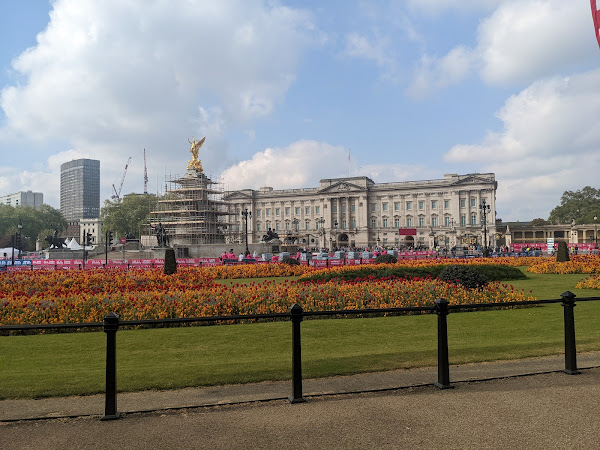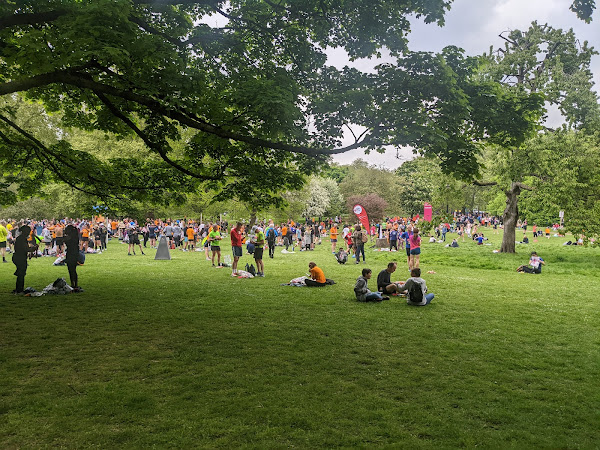After the Brighton Marathon, my attention for my running training has switched to the autumn, and running my first half marathon. Along the way, I want to make efforts to incorporate more speed than I was able to while training for the full marathon, and so I intend to use several 10k races, alongside parkrun to help gauge my progress!
My training block for the half marathon will consist of around 16 weeks of training, with the London 10k being the first of those efforts.
Target
According to Garmin, my current 10k PB is 52:14, which set during Brighton Marathon! Various calculators, such as Jack Danaiels' Equivalent Pace calculator suggest that I could theoretically have run a 46:58 10k a few weeks ago, but I have taken some time to recover after the marathon, and so I am only taking two goals into the race; set a new PB, and/or run sub 50 minutes.
Training
Unfortunately, training for this run was perhaps less than ideal. My main training so far this year had been geared towards Brighton Marathon, with a good number of tempo efforts at parkrun thrown into the mix, and since the marathon, my main focus has been on recovery rather than anything specific for this race. Going into this race, it would be fair to say that I definitely wasn't as trained as I was going into Brighton!
Race pack
Unlike Brighton Marathon, London 10k has a policy of mailing race packs to participants, which include race numbers with timing chips, safety pins, a kit bag, and a number sticker to attach to the kit bag.
Packs were scheduled to arrive week commencing 25th April, and it was very relaxing to see my pack arrive on the Monday. When compared to my race pack collection experience at Brighton, this approach is definitely far more preferable, and entirely stress-free! Another benefit is that I could check and have confidence that my kit would definitely fit in the kit bag before leaving home!
Arriving
Although transport was a challenge at Brighton, I decided to travel to London on the day as the trains and the tube are typically reliable enough, and I could fall back on driving to the event if there were any problems.
Arriving at the race start was a simple endeavour, involving a train ride to St Pancras, a tube to Green Park, where the entrance to the race village was metres from the exit of the tube station!
On arrival, I changed into my race gear relatively early so that I could drop off my bag, and get a warmup in before the race while others were still arriving.
By the time I had finished my warmup, the park was bustling with activity!
Before too long, runners in the yellow and black waves were asked to move to the start area, and eventually to move into the starting pens.
The race
The elite athletes were introduced after arriving in the start area, with Mo Farah getting a huge cheer, and without further ado, we were on our way! I found myself constantly regulating my pace throughout the race, as I'm much more used to running 5k distances, and so I didn't want to risk digging a hole for myself that I couldn't get out of later.
Something that isn't highlighted in the event material is that the route actually undulates quite significantly, which adds up, especially if my Garmin trace is to believed (it reported 90 metres total elevation)!
Fortunately, I managed to regulate myself to a finish time of 49:52, meaning I achieved both of my goals for this race of beating my previous 10k PB, while also breaking 50 minutes! One definite highlight was seeing the leading group (including Mo) running in the opposite direction as I passed the 2km marker!
Recovery
After the race had ended, I implemented some lessons from Brighton, drinking a bottle of water, as well as a protein shake I had prepared earlier, and I took some time to relax in Green Park before doing anything else!
Lessons / reflections
Reflecting on the day, there isn't really anything I would change - the race went as well as I could manage without any real training in the prior 4 weeks, and I found the logistics to be excellent, especially the proximity of the race village to Green Park tube station! My only hope is that future races are as smooth as this one!
What's next
My next goal is to begin training for an autumn half marathon, and I will plan several other shorter races along the way to help measure my progress. The next race is likely to be in June, which will hopefully give me some time to train a little first!
Links: Results | Strava | Race report
References: Vitality London 10,000 | Course map | Event guide | Jack Daniels' Equivalent Pace Calculator








